Table of contents
- Report tire service in MotoGP Black magic
- Incredible lean angle, tough stamina
- Problem stable temperature window
- Driving stability, grip, traction, handling
- As if a shark had bitten into it
- The main stress on the tires moved inwards
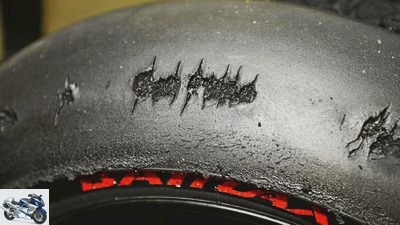
2snap
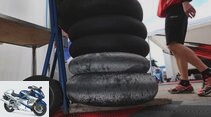
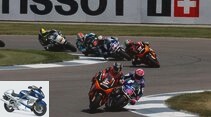
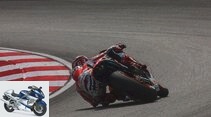

24 pictures
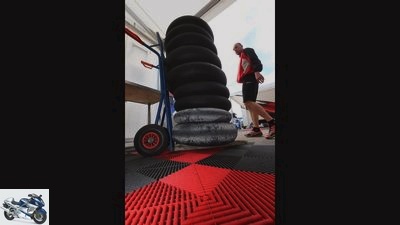
2snap
1/24
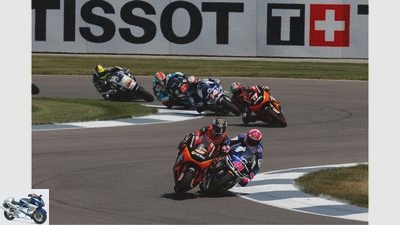
2snap
2/24
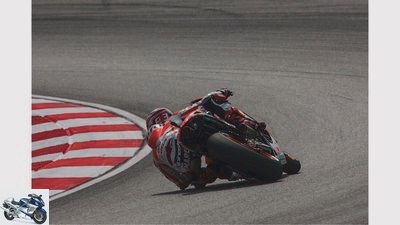
2snap
3/24
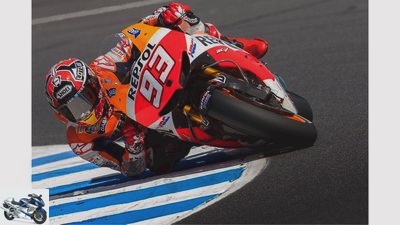
2snap
4/24
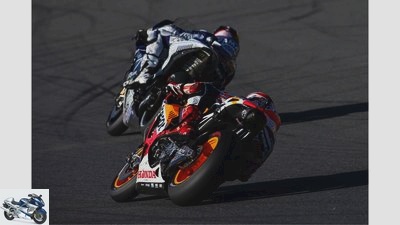
2snap
5/24
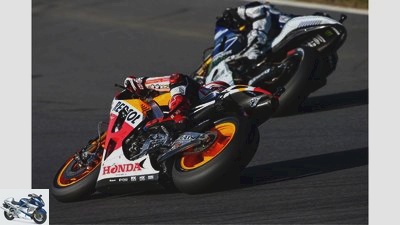
2snap
6/24
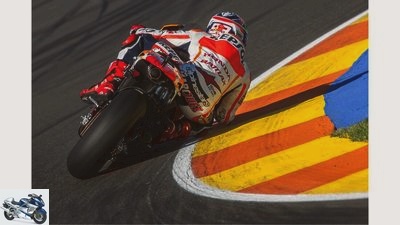
2snap
7/24
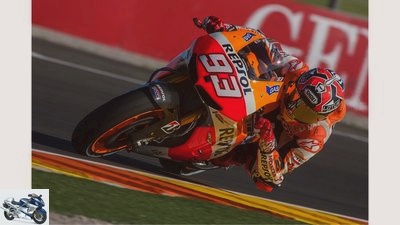
2snap
8/24
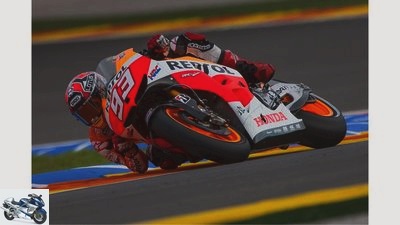
2snap
9/24
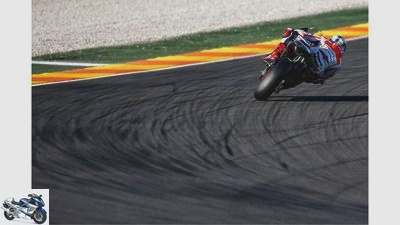
2snap
10/24
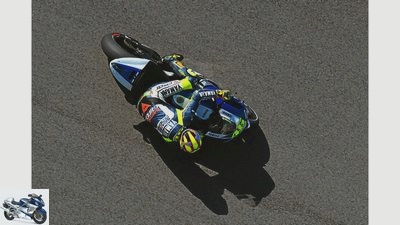
2snap
11/24
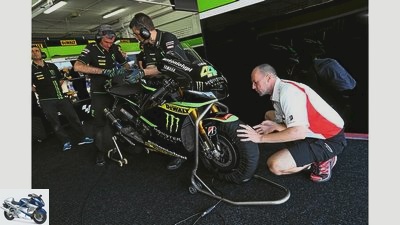
2snap
12/24
Peter Baumgartner (right) has the Yamahas constantly in view. He looks after the factory and Tech3 team.
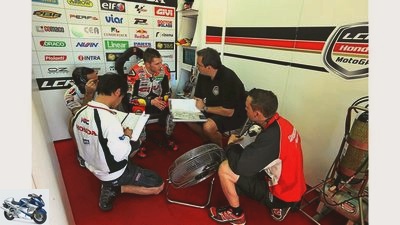
2snap
13/24
As soon as the racing driver has dismounted and describes his impressions, the Bridgestone man sits there, listens and gives tips.
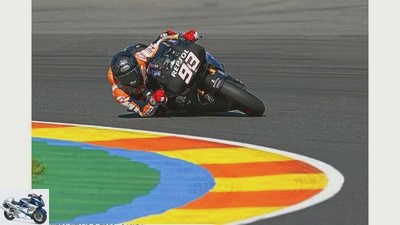
2snap
14/24
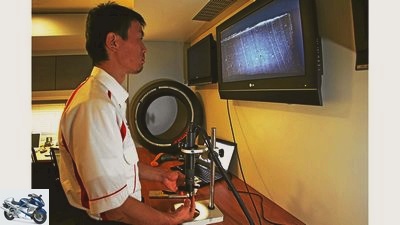
2snap
15/24
A simple sample for laypeople, an open book for tire experts: a tire test piece under the microscope.
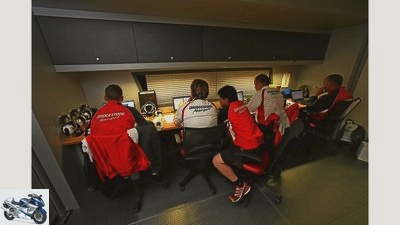
2snap
16/24
The Bridgestone truck. Here data is determined, collected and kept secret from unauthorized persons.
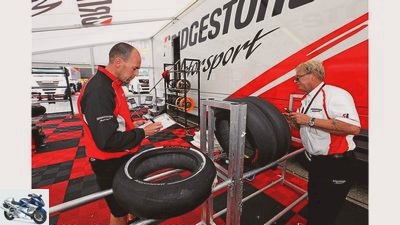
2snap
17/24
No tire is lost. Even worn tires are neatly noted and stored.
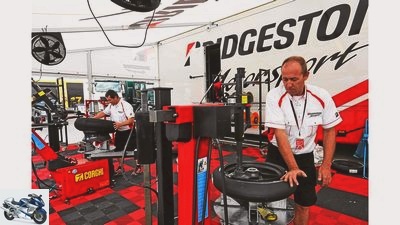
2snap
18/24
Continuous stress: As with every race training session, the Grand Prix hero is put together as much as he can between the turns.
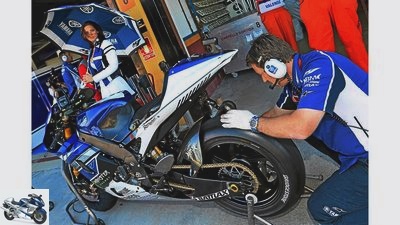
2snap
19/24
The drivers and their technicians decide on the mixture used for the race and qualifying from two predefined types.
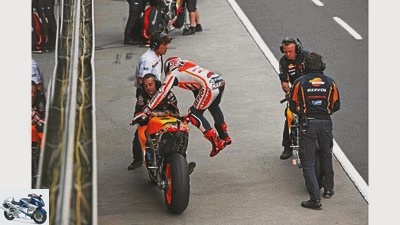
2snap
20/24
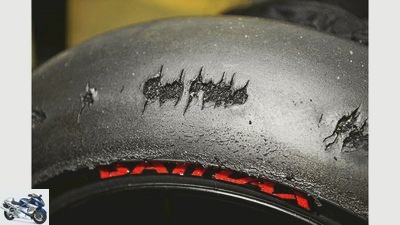
2snap
21/24
As if the great white shark had bitten: disaster loomed in Phillip Island. Thanks to careful analysis and checks, all drivers were safe.
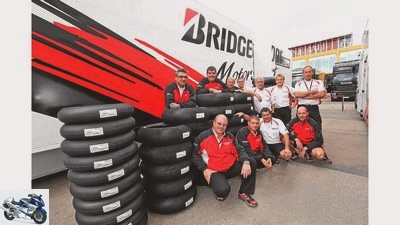
2snap
22/24
Thomas Scholz’s tire squad (from left) in MotoGP. Almost all of the technicians come from Germany.
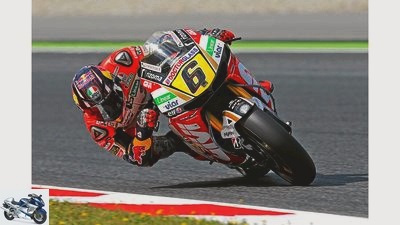
2snap
23/24
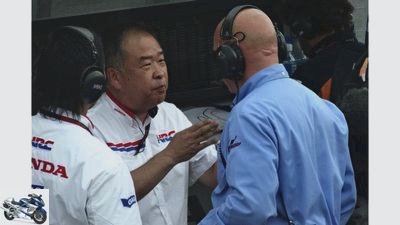
2snap
24/24
Sports & scene
Motorsport
Report tire service in MotoGP
Report tire service in MotoGP
Black magic
Content of
Secrecy and trust – the Bridgestone tire service in MotoGP is a kind of secret society. At the end of the 2013 season in Valencia, PS was allowed to ask more questions.
Friedemann Kirn
December 19, 2013
The Holy of Holies stands on a simple table at the windowless front of the truck. An engineer is sitting in front of it and is concentrating on the high-resolution screen on the wall, which is constantly showing new structures. Millimeter by millimeter, the Japanese man pushes a piece of tire tread under the optics of the electron microscope.
Buy complete article
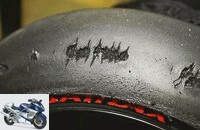
Report tire service in MotoGP
Black magic
6 pages) as PDF
€ 2.00
Buy now
The images on the monitor are sometimes reminiscent of ultrasound, then again of confused ink blots. They are meaningless to laypeople, and would be of inestimable value to competitors. Precise conclusions can be drawn from these structures about the structure and function of the Bridgestone MotoGP slicks. The macro shots are therefore strictly secret and are carefully kept under lock and key, as are the thin, slightly more than finger-length tread samples. They look harmless, a bit as if someone had peeled black asparagus. In reality, these rubber threads are also highly explosive. Analyzing them, figuring out the ingredients and then recreating such a tire would be a breeze for and for other tire manufacturers Bridgestone thus a long and damn expensive development lead.
Incredible lean angle, tough stamina
All tire samples are therefore carefully numbered and collected. Unthinkable if one or two of these thin strips were lost. Not to mention complete tires. But even something like that has happened when a few years ago a significant portion of the cargo for Phillip Island suddenly went undetectable. Wherever Thomas Scholz, the German head of operations for the Bridgestone MotoGP engagement, had someone searched, in freight containers, on freight forwarding parking lots, in aircraft hangars, the tires seemed to have vanished into thin air. They did not reappear until weeks later, in an apparently rarely used cargo compartment under the cockpit of the cargo plane. In the meantime they had traveled around the world several times. “The suicide-prone Japanese managers could breathe a sigh of relief,” laughs Scholz, who, as a long-time fellow traveler of the MotoGP convoy, can tell a number of such anecdotes.
The meticulous attention to secrecy is not only due to the unbelievable lean angle that the driver can reach with the slick. The almost 60 degrees with which the MotoGP aces hone the corners is also reached by the Dunlop riders of Moto2 and Moto3 or the superbikers on their Pirellis. The decisive factor is which twist of the throttle, how much propulsion the Bridgestone tires allow even when the vehicle is leaning to the maximum. “If you go to the limit and push hard, you will realize just how far you can go with these tires,” says MotoGP world champion Marc Márquez.
The tough stamina of the tires is just as impressive, because both Márquez and the old champion Jorge Lorenzo often turned their fastest laps in the final stages of the races.
Problem stable temperature window
There is only one problem that is constantly on the agenda: a stable temperature window. One of the most difficult routes in this regard is the Sachsenring. There were also severe temperature fluctuations there in the summer of 2013 – cool in the mornings and summer sun in the afternoons. Above all, there are only three right turns there. The rest of the route consists of left-hand bends, some of which have very long radii, in which the drivers spend a long time in full banking and build up a lot of heat in the left flank of the tire. The right tire flank, on the other hand, cools down, which can be uncomfortable in the next right-hand bend. More than 30 falls in three Grand Prix classes in the training sessions speak for themselves.
As a MotoGP exclusive supplier, Bridgestone had to react and brought asymmetrical slicks with them to the Sachsenring, where the spread between the soft compound for the right and the hard compound for the left flank was greater than for any other track on the Grand Prix calendar. In addition, Bridgestone used a special, heat-resistant construction in which the temperature generated by flexing in the carcass was less able to penetrate the surface.
Driving stability, grip, traction, handling
Despite such special solutions, many observers wonder what the drivers and the three of the respective manufacturers Yamaha, Honda, Ducati and three Bridgestone technicians assigned to the Claiming Rule Teams actually constantly discuss at their meetings in the pits, given the uniform tires that are the same for all to have. “First and foremost, it’s about setting the weekend quota,” says Klaus Nohles, another of the many Germans in the Bridgestone MotoGP team who looks after Honda. Over the year, Bridgestone offers four different compounds for the front wheel and five for the rear wheel and preselects the two most suitable tire types for each racetrack. On Wednesday evening, each driver is assigned six front tires (three hard, three soft) and nine rear tires (four hard, five soft). On Friday evening, after the first two training sessions, the driver makes the choice of three additional front and two additional rear tires, so that he can get a maximum of seven soft rear tires.
Detailed criteria are also queried after each training session. Driving stability, grip in different lean angles, traction when accelerating out or handling are recurring topics. “Sometimes, however, you also need a sure instinct and just waiting to see what impressions the driver himself makes,” explains Peter Baumgartner, who is responsible for Yamaha. The tall man from Palatinate has been with us since 2001 and is a sought-after man from Valentino Rossi to Bradley Smith, because the tire guys are constantly being pestered by the drivers about durability, chassis reactions, the right rim widths and optimal tire pressure. Above all, however, drivers and technicians want to know what is happening to the tires in the neighboring pit. “That is information that we have to deal with very discreetly. Trust is everything in business, ”says Baumgartner.
If Bridgestone got the temperature problem under control at the Sachsenring, the Australian Grand Prix already had a red alert on the first day of training. Brought to 80 degrees with tire warmers in the box before assembly, the tread temperature continues to rise during normal racing, but rarely over 130 degrees. But suddenly up to 185 degrees were measured in Phillip Island. Even in the run-out lap, the tire sidewalls were still up to 140 degrees – and the chemical reactions below the tread were out of control. Reaching for the microscope was suddenly everything: after the individual tires had been cut open on Friday evening, the engineer was able to prove that the tread was beginning to detach itself from the carcass with air bubbles the size of a pinhead.
As if a shark had bitten into it
The GAU was there. In previous years, Bridgestone had mastered the challenges of the fast left turns at Phillip Island with appropriately hard tread compounds. However, several factors came together in a fatal way on the new surface, which was also used to iron the bumps in the road. The new asphalt is extremely sharp-edged and the surface is perfectly flat. While the old bumps had repeatedly allowed the rear tire to take short, temperature-reducing rest periods, it now went smoothly through the corners, which further accelerated the temperature build-up in the tire flank. In addition, instead of the normally prevailing, cool early spring weather, it suddenly appeared that midsummer had broken out. In addition, a lot of greasy oil had evaporated from the new asphalt in the past few months. The grip and aggressiveness of the surface had increased significantly – and increased with every training lap on which additional rubber abrasion stuck.
After Bridgestone withdrew the softer mixture, the harder version also showed signs of stress. The technicians conjured up an extra-hard emergency mix from the container. But even this last, ultimate safety reserve failed, which is why the race had to be divided into two parts. The fact that these ten laps per tire were the maximum was shown by the rear tire of the disqualified Marc Márquez, who had completed eleven laps before changing the machine (see photo show). Its tread looked as if a shark had bitten into it. The tire would hardly have survived another lap. “It wouldn’t have exploded like at Shinya Nakano in Mugello in 2003,” explains Baumgartner. Back then it literally tore the rear tire of the Kawasaki star to pieces at 340 km / h. The “crossbelt” construction of the carcass substructure was completely changed after this spectacular accident. With the newer monospiral construction, such damage is as good as impossible. “The air would definitely have stayed with Marc’s tires,” assures Baumgartner.
The main stress on the tires moved inwards
The complexity of these developments is not noticed by the fans in the stands, but it is essential for the show as well as the safety of the drivers. Although the contour of the tires goes back to 2008, the carcass construction and the tread compounds have changed again and again. In 2012, the displacement was increased from 800 to 1000 cm3. Since then, Bridgestone has observed that the main load on the tires moved from the outermost flank inwards. This fits in with the changing driving style, which has changed from the long curve radii to the sharp “aim-and-shoot” style, in which the driver applies the brakes as straight as possible to the apex of the curve, briefly flips them, straighten up again as quickly as possible and the torque use the huge engines for optimal thrust.
“It was surprising,” says Peter Baumgartner, “that the tire temperatures tend to be lower with this type of driving.” Which is why soft compounds are in demand. The hardest was even declared unusable by the drivers. At Baumgartner’s suggestion, there is therefore a further development step for 2014. Tested for the first time in Misano and confirmed as good at the season finale in Valencia, this generally hard tire offers more grip on the sidewalls. How this was achieved cannot, of course, be elicited from the Bridgestone technicians. Just this much: It is not just a multicompound construction with a significantly softer tread on the outermost flanks, but also a construction method that fits this idea.
Secrecy is an important part of business. This not only affects journalists, but also drivers. When Marc Márquez wanted to take his used rear tire as a souvenir after winning the title in Valencia, the Japanese Bridgestone manager Hiroshi Yamada was appalled. As a compromise, Márquez got one of those tires that are only fitted for the transport of the racing machines and, apart from the color, have nothing to do with the current racing slicks. “We have scratched our heartfelt congratulations on this ‘Traveler’,” laughs Thomas Scholz. In the coming season he will again experience exciting things to do with black gold for his endless pool of curious Grand Prix stories – guaranteed.
Related articles
-
Kirn 10 pictures Kirn 1/10 Kirn 2/10 Kirn 3/10 The pillars of Bridgestone MotoGP engagement: MOTORRAD interview partner Thomas Scholz (front) and his…
-
2snap Sports & scene Motorsport Report: MotoGP technology The technology in the MotoGP class Stefan Bradl on the bikes in the premier class Content of…
-
2snap Sports & scene Motorsport Tires in MotoGP Tires in MotoGP The price of the unit Content of Years ago, as the MotoGP organizer, Dorna issued rules…
-
Report on driving techniques in MotoGP
2Snap Sports & scene Motorsport Report on driving techniques in MotoGP Driving Techniques in MotoGP: Then and Now That’s how the pros drive Content of…
-
Sport: MotoGP – driving report Kalex-Moto2
Photo 2snap motorcycles Sport: MotoGP – driving report Kalex-Moto2 Sports MotoGP – driving report Kalex-Moto2 Just four months before the premiere of the…
-
Alpinestars racing service MotoGP
Jahn 19th pictures markus-jahn.com 1/19 markus-jahn.com 2/19 The leather suit has been repaired and will be made ready for return to the box….
-
MotoGP Mugello 2018 Race Report Grid Girls
2snap 22nd pictures 2snap 1/22 Also on site at the MotoGP race in Mugello: pretty grid girls from the beverage manufacturer Monster Energy. 2snap 2/22…
-
Service test of tire manufacturers and buying portals
BILLION 18th pictures Jahn 1/18 Jahn 2/18 The inquiries concerned, among other things, recommended replacement intervals … Lohse 3/18 Exotic brands…
-
MotoGP in Jerez Spain 2016 Race report and pictures
2snap 27 pictures 2snap 1/27 Grid Girls from the race weekend in Jerez 2016. 2snap 2/27 Pictures from MotoGP race in Jerez, Spain 2016. 2snap 3/27…
-
MotoGP 2016 in Assen Race report and pictures
2snap 24 pictures 2snap 1/24 MotoGP 2016 in Assen (Netherlands): Marc Márquez. 2snap 2/24 MotoGP 2016 in Assen (Netherlands): Maverick Viñales. 2snap…